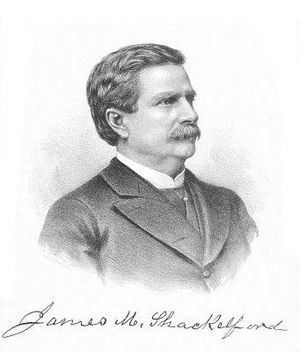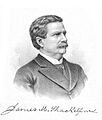James M. Shackelford facts for kids
Quick facts for kids
James M. Shackelford
|
|
|---|---|
 |
|
| Born | July 7, 1827 Lincoln County, Kentucky |
| Died | September 7, 1909 (aged 82) Port Huron, Michigan |
| Place of burial |
Cave Hill Cemetery, Louisville, Kentucky
|
| Allegiance | United States Union |
| Service/ |
United States Army Union Army |
| Years of service | 1847–1848, 1861–1864 |
| Rank | |
| Commands held | 25th Kentucky Infantry Regiment 8th Kentucky Cavalry Regiment 4th Division, XIII Corps Cavalry Corps, Army of the Ohio |
| Battles/wars | Mexican War American Civil War |
| Other work | lawyer, judge |
James Murrell Shackelford (July 7, 1827 – September 7, 1907) was an important person in American history. He was a lawyer, a judge, and a general in the Union Army. This was during the American Civil War. He is famous for capturing a well-known Confederate leader, John Hunt Morgan. This happened in 1863 and stopped a big raid called "Morgan's Raid".
Contents
Early Life and First Military Steps
James Shackelford was born in Kentucky in 1827. His family had lived in Virginia since the 1600s. When he was young, Shackelford joined a group of Kentucky volunteers. He became a second lieutenant in the army. This was just in time for the Mexican–American War.
The fighting had mostly stopped by the time his group reached Mexico. But Shackelford showed great soldier skills. Because of this, he was promoted to first lieutenant. After the war, he went back to Kentucky. He started studying law with a local judge. In 1851, he became a lawyer. His law career was going very well until the Civil War began.
Civil War Service
Joining the Union Army
On January 1, 1862, Shackelford became a colonel in the 25th Regiment Kentucky Volunteer Infantry. His regiment joined a larger army group. They fought in the Battle of Fort Donelson. This battle was very tough. The harsh weather made Shackelford sick. Because of his poor health, he had to leave the army on March 24, 1862.
While he was recovering, Shackelford helped recruit more soldiers. He formed another group of Kentucky volunteers. This new group became the 8th Regiment Kentucky Volunteer Cavalry. Shackelford was again their colonel. A few months later, on January 1, 1863, he was promoted. He became a Brigadier General of Volunteers. He was put in charge of a brigade in the XXIII Corps.
Chasing John Hunt Morgan
In July 1863, Shackelford took part in a special mission. He joined Edward H. Hobson's group. Their goal was to catch a famous Confederate raider, John Hunt Morgan. Union forces finally caught up with Morgan. This happened at the Battle of Buffington Island in southern Ohio.
Half of Morgan's Confederate soldiers surrendered there. But nearly 400 of them, including Morgan, escaped. They ran along the north bank of the Ohio River. Shackelford's brigade kept chasing them. They finally trapped Morgan's remaining force. This happened at the Battle of Salineville in northeastern Ohio. Shackelford's actions effectively ended Morgan's big raid.
Campaigns in Tennessee
Later that year, General Ambrose Burnside marched his army toward Knoxville, Tennessee. He passed by the Cumberland Gap. He left one group of soldiers there. Burnside took control of Knoxville on September 1, 1863. Then he focused on the Cumberland Gap again. He sent Shackelford's brigade to take it.
Shackelford demanded that the Confederate general, John W. Frazer, surrender the gap. But Frazer refused. Burnside himself arrived with more soldiers. This forced the Confederates to surrender. Later that month, Shackelford was promoted again. He took command of a division in the XXIII Corps. In November, he led the Cavalry Corps in the Army of the Ohio.
Shackelford's cavalry helped to protect important roads. This happened at the Battle of Campbell's Station. He also took part in the Siege of Knoxville. When Confederate forces led by James Longstreet left Knoxville, Shackelford chased them. He caught up with the Confederates. But at the Battle of Bean's Station, Longstreet stopped the Union chase. Then Longstreet's forces left the area.
Later Life and Legal Career
On January 18, 1864, Shackelford suddenly left the army. This was because his wife had passed away. He moved to Evansville, Indiana. There, he started his law practice again.
Becoming a Federal Judge
Before 1889, there were no federal courts in Indian Territory. Only tribal courts were there. But when new land was opened for settlers, many lawyers came. These lawyers could work in American courts.
In 1889, President Benjamin Harrison chose Shackelford. He appointed him as a U.S. judge in the Indian Territory. He took the place of Judge Isaac Charles Parker.
Death and Burial
James M. Shackelford died in the fall of 1909. He passed away at his summer home in Port Huron, Michigan. He is buried in Cave Hill Cemetery in Louisville, Kentucky.
Images for kids


